How corn grows: photos and stages of cultivation, advice from experienced farmers
Man has been eating corn for a long time. For the first time this plant was domesticated in the territory of modern Mexico 2000 years ago. This country is considered the world leader in the consumption of corn. Every Mexican eats over 90 kg of golden grains annually.
In Russia, corn is not so popular. But many grow sugar cobs in the country and in the garden. In this article, we will talk in detail about how to grow corn outdoors, and whether it is economically profitable to cultivate this cereal for commercial purposes.
The content of the article
Growth stages of culture and ripening periods
In the southern regions, corn grows well in the open field and is grown directly from seed... In regions with colder climates, short and cool summers, the seedling method is used.
The prepared seeds are sown in a greenhouse or greenhouse and planted in open ground with the arrival of heat. The seedlings are transferred to a permanent place when the soil warms up to + 12 ... + 13 ° С.
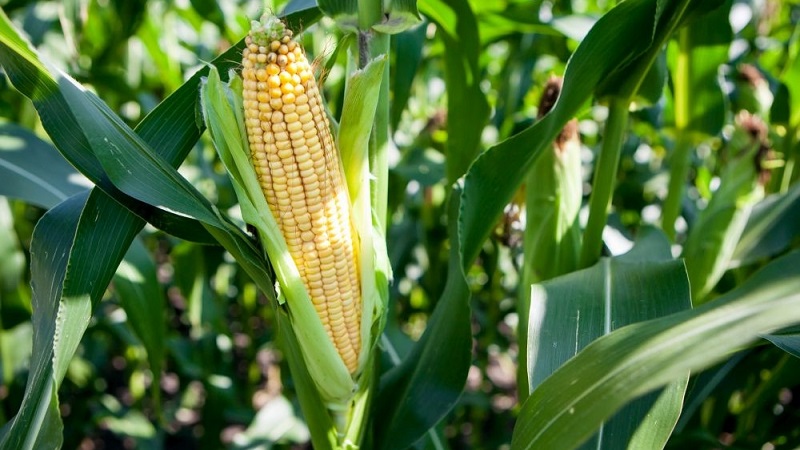
Consider the growth of corn in stages:
- The beginning and full emergence of seedlings - the root system of the cereal is formed.
- The beginning and full appearance of panicles - the aerial parts of plants develop intensively.
- The beginning and full flowering of the cobs. At this stage, it is important to moisturize and fertilize the soil. Lack or excess of moisture, lack of nutrients during the flowering period worsen fertilization and reduce the grain size of the ears.
- Milk ripeness. Inside the grains have a liquid consistency, when crushed, a milky-white liquid is released.
- Milky-wax ripeness. The grain is compacted, less juice is released.
- Wax ripeness. The grains become dense, no juice is released when pressed.
- Full (technical) ripeness. A black dot appears at the base of the grain.
Ripening times vary depending on the variety and region of cultivation... On average, from the moment of seed germination to the onset of technical ripeness, it takes from 65 to 150 days.
Description of the stages of growing on a personal plot
Growing the queen of the fields in the country begins with variety selection or a hybrid culture.
Choosing a variety or hybrid
There are many varieties and hybrids of corn. The variety is chosen based on the goals of cultivation: for fresh consumption, preparations for the winter or freezing.
Distinguish:
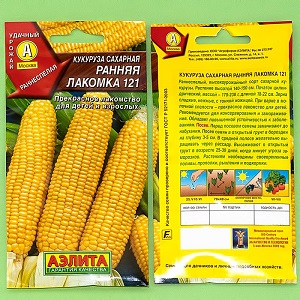 Early varieties - Sundance, Gourmet 121 (pictured), Trophy F1, Landmark F1. They give a good harvest in a short time. Plants tolerate transplanting well and are often grown via seedlings. From the moment the shoots appear until milk ripeness, an average of 65-89 days pass. They are used fresh (boiled).
Early varieties - Sundance, Gourmet 121 (pictured), Trophy F1, Landmark F1. They give a good harvest in a short time. Plants tolerate transplanting well and are often grown via seedlings. From the moment the shoots appear until milk ripeness, an average of 65-89 days pass. They are used fresh (boiled).- Mid-season varieties - Mermaid, Favorite, Pearls, Spirit F1. More resistant to adverse weather conditions. They sit for a month longer. Suitable for fresh consumption, canning and freezing.
- Late varieties - Bashkirovets, Polaris, Russian bursting 3. The most fruitful, but also long-ripening varieties. Some specimens grow up to three meters in height. The ripening period lasts up to 150 days. Resistant to disease and lodging. Versatile to use.
Seed preparation
Corn is grown in two ways: sowing seeds directly into open ground and through seedlings. The seedless method is less laborious, but does not allow an early harvest. In this case, crops are more resistant to the whims of nature.
One week before sowing the grains are heated at a temperature of + 35 ° C. Seed material is soaked and remove floating instances. Quality grain is wrapped in a wet cloth and kept moist until germination.
Before planting, the seeds are disinfected. from pests and diseases. To do this, they are soaked in a solution of potassium permanganate, aloe juice or the preparations "Merkuran" or "Granosan".
Grain for seedlings is planted in plastic or peat cups... The diameter of one container is about 10-12 cm. The glasses are filled with a mixture of sod substrate and humus or compost in a 1: 1 ratio.
Prepared seeds are planted to a depth of 3-4 cm... Young plants are planted in a permanent place after a month.

Soil preparation
Soil preparation begins in the fall and consists of harvesting predecessors, digging and fertilizing.
For sowing, choose a well-lit area, protected from cold winds. Corn loves fertile soil: black earth, loamy and sandy loam with good aeration and water permeability.
The best predecessors for corn are winter and spring cereals, legumes, cabbage, tomatoes, melons.
Important! Like all grains, corn absorbs a lot of nutrients from the soil, so it is not cultivated in the same place for more than two years in a row.
In the spring, the soil is loosened to the seeding depth... This will saturate the soil with oxygen, retain moisture and accelerate the emergence of sprouts.
Landing
Seeds are sown in open ground after the soil warms up to + 12-13 ° С... The landing pattern is determined based on the manufacturer's recommendations. On average, a distance of 50-60 cm is maintained between rows, and between plants - 30-40 cm.
Seeds are embedded in prepared and moistened soil to a depth of 6-8 cm and sprinkled with earth.
When planting through seedlings, holes are prepared in advance a little more deep than a glass. Then the plants are watered and mulched.
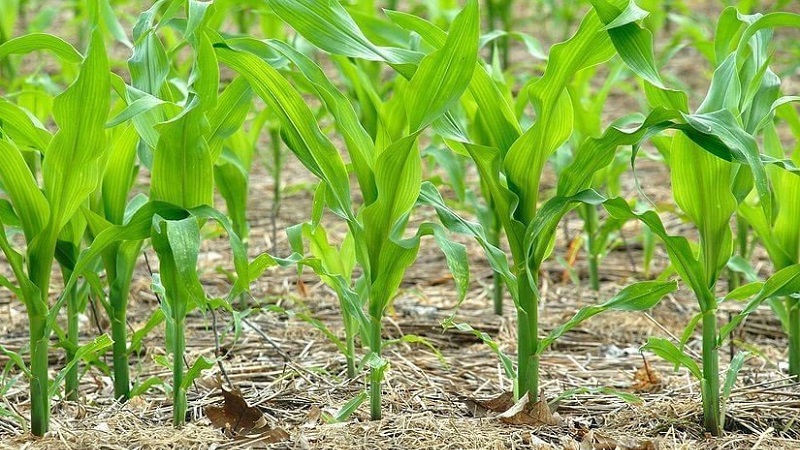
Care
Whatever you grow, it is important to properly care for the plantings... Caring for corn beds is reduced to watering, fertilizing, protecting against pests and diseases.
How much water does crops need? The intensity of watering depends on climatic conditions and the stage of plant growth... The culture experiences the greatest need for moisture in the phase of development of 9-11 leaves, when the plant is actively increasing its green mass, and during the flowering period. Lack of moisture reduces the quantity and quality of the crop.
After watering, the soil is loosened, along the way, removing weeds... Loosening and weeding is especially important at the initial stage of plant development.
Top dressing is applied twice:
- the first - at the stage of formation of 3-4 leaves (organic fertilizer);
- the second time - at the stage of sweeping panicles (mineral).
Diseases and pests
Corn crops are susceptible to fungal diseases... The most dangerous of them:
- Fusarium... It affects the ears, stems, young shoots. Reduces yield by half. It is characterized by the appearance of a pink coating on the cob. Subsequently, the grains darken and collapse. The disease spreads due to the high acidity of the soil, excess moisture, a decrease in air temperature, and thickening of crops. As a result of the vital activity of the fungus, toxins accumulate in the tissues of the plant, which are dangerous for humans and animals.
- Rust... The causative agent of the infection becomes more active in July. Light yellow spots appear on the underside of the leaf, which eventually darken and become covered with pustules with fungal spores.
- Bubble smut... Fungal disease, accompanied by the appearance of neoplasms on foliage and ears. Develops due to prolonged drought.
For the prevention of fungal diseases seeds are treated with fungicides "Vitavax", "Vitalon", "Alios", etc. The working liquid is prepared in accordance with the instructions on the package.

Common pests in corn fields include:
- The wireworm is the larva of the click beetle. Loves high humidity.The larvae gnaw the root system of plants and are able to completely destroy crops.
- Larvae scoops. Cotyledon leaves and young corn sprouts are devoured, as a result of which the plants stop growing and die.
Treatment of crops with insecticides "Kinfos", "Karate Zeon", "Tsiperus" and others helps to protect against pests.Spraying is carried out during the growing season:
- when the first wave of pests appears;
- in two weeks.
Working fluid consumption - 200-400 l / ha.
Preventive measures include observance of the rules of crop rotation, deep plowing in autumn, spring cultivation.
Harvesting and storage
The ears, intended for consumption in raw, boiled or canned forms, are harvested at the stage of milky ripeness. At this stage, the beans have a mild sweet taste. First, the heads of cabbage are removed, located closer to the top of the stem. They keep up first.
The following signs indicate that the cobs are ready to harvest:
- the heads of cabbage deviated to the side;
- the panicle at the end of the ears began to dry out;
- the ears are completely filled with grains;
- the grains turned pale yellow;
- when pressed on the grains, a white liquid resembling milk is released.
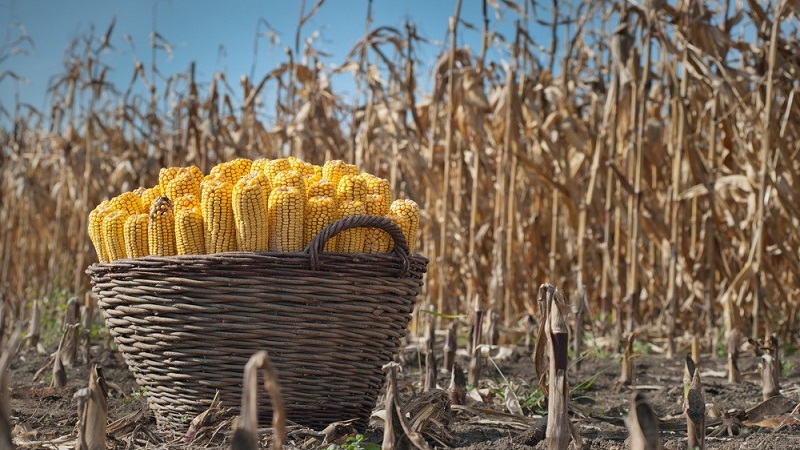
Delaying the harvest time leads to the fact that the fruits lose their juiciness and sweetnessand the grains become tough.
Once the ears are removed from the stalk, the sugars in the corn kernels begin to convert into starch.... Therefore, the harvested corn is eaten, canning or freeze within days of collection.
Features of cultivation depending on the region
The agrotechnology of corn cultivation differs depending on on the climatic conditions of the region:
- In the Krasnodar Territory, both early and mid-season and late varieties of culture are grown everywhere. In this case, direct sowing of seeds in open ground is used.
- In the Leningrad Region and the Moscow Region, preference is given to early and mid-season varieties. Here sowing in open ground and cultivation through seedlings are used.
- In the climatic conditions of the Urals and Siberia, it is preferable to plant heat-loving corn through seedlings. Then the cobs will have time to ripen before the end of the garden season.
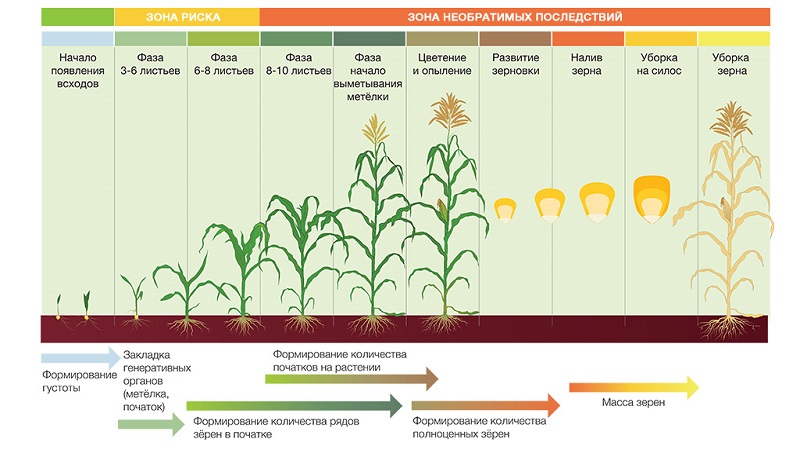
Growing corn as a business
Growing corn is a profitable business... Culture is in great demand. Golden grains are canned, flour, butter, flakes, popcorn are made of them. Corn is used when preparing feed for livestock, for industrial purposes: in the production of alcohol, paste, plastic, plaster, filters. Moreover, they use not only grains, but also foliage, stalks and wrappers of the cobs.
Culture grows well at an average temperature of + 25 ° С... At high rates - above + 32 ° С - the yield decreases. Also, plants are demanding on sunlight. The daylight hours should be at least 12 hours.
The Krasnodar Territory is considered the leader in corn cultivation. Quite good yield in the Voronezh and Belgorod regions. The lion's share of the crop is used for animal feed, the rest is used in the food industry. About a quarter of the harvested corn is exported.
Favorable precursors for cereals - legumes and pumpkin plants. In autumn, the land is plowed, top dressing (manure) is applied. Potash and nitrogen fertilizers are added in the spring.
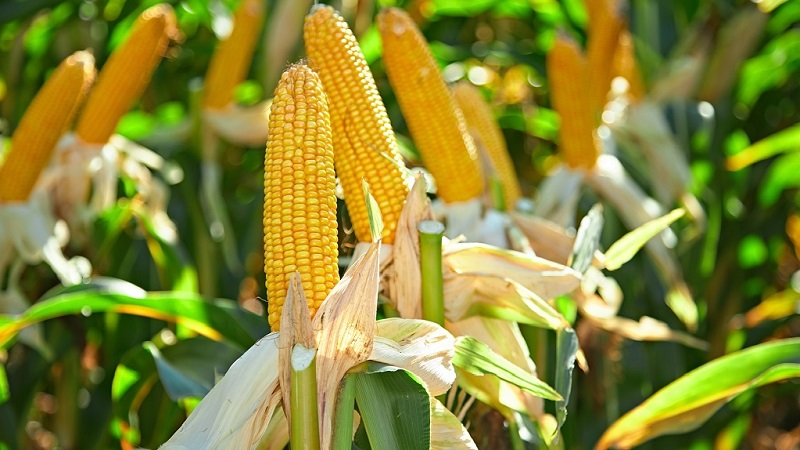
If you planned to plant 56 thousand plants per hectare, then 4.3 grains are needed per 1 running meter. Further, depending on the weight of the grains, the number of kilograms per hectare is calculated. For example, if the weight of 1000 grains is about 200 g, then to sow a hectare, you will need 11 kg of seed. Thus, the cost of seeds will be about 30 thousand rubles.
The cost of renting land ranges from 1,500 to 5,000 rubles. Plowing one hectare of land costs about 4000 rubles. A corn seeder is rented or bought. The price of the unit is from 500 thousand rubles. up to 1.5 million rubles.
For pest control plants and soil are sprayed with chemicals. Drip irrigation is used as irrigation. The average water consumption rate is 35 m³ / ha.
Harvesting is carried out in the phase of milk ripeness. The later you harvest, the more starch and less sugar in the grains.
The total cost of wages, equipment, fertilizers will be approximately 60-70 thousand rubles. The yield per hectare is about 85 thousand ears when 60 thousand plants are planted.Profitability reaches 700%... This is one of the highest rates in agriculture.

Tips and tricks from experienced farmers
The following tips and recommendations will help novice gardeners in growing healthy cereals:
- Harvesting start at a grain moisture content of 70-75%. If dimples form on the top of the grains, then the humidity has decreased to critical values.
- Immediately after harvesting, the long stems of the cobs and stipules are removed - they draw moisture from the grains.
- After harvesting, the cobs are used for food or canned as soon as possible. Grain quickly loses sugar and delicate taste.
- At zero temperature and 90% humidity, the ears are well stored for about a week. If the temperature is higher, for example + 5 ° C, the storage period without loss of quality is reduced to 3-4 days, at + 10 ° C - up to two days.
- The roots of young shoots are located close to the soil surface, therefore, be careful when loosening and weeding.
- It is good to plant corn next to beans, pumpkin, cucumbers. With its wide leaves, it shades the soil, prevents the growth of weeds and the evaporation of moisture. The powerful corn stalks support the climbing beans, which in turn enrich the soil with nitrogen.
Conclusion
The cultivation of tasty and healthy sweet corn is a simple process. The main thing is to choose the right variety and provide the plants with proper care. Golden grains are delicious and healthy, your household will appreciate fresh boiled ears and corn blanks for the winter.
With the right approach, growing corn turns into a profitable business. The main thing is to think in advance about how the harvest will be realized, because the harvested ears are stored for a short time.